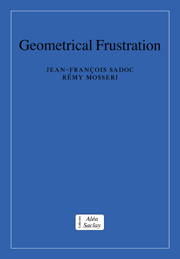Book contents
- Frontmatter
- Contents
- Preface
- 1 Introduction to geometrical frustration
- 2 Ideal models
- 3 Finite structures
- 4 Decurving and disclinations
- 5 Hierarchical polytopes
- 6 Some physical properties
- 7 Periodic structures with large cells
- 8 Quasiperiodic order and frustration
- A1 Spaces with constant curvature
- A2 Quaternions and related groups
- A3 Hopf fibration
- A4 Polytopes and honeycombs
- A5 Polytope {3, 3, 5}
- A6 Frank and Kasper coordination polyhedra
- A7 Quasiperiodic tilings: cut and projection
- A8 Differential geometry and parallel transport
- A9 Icosahedral quasicrystals and the E8 lattice
- Bibliography
- Index
8 - Quasiperiodic order and frustration
Published online by Cambridge University Press: 06 January 2010
- Frontmatter
- Contents
- Preface
- 1 Introduction to geometrical frustration
- 2 Ideal models
- 3 Finite structures
- 4 Decurving and disclinations
- 5 Hierarchical polytopes
- 6 Some physical properties
- 7 Periodic structures with large cells
- 8 Quasiperiodic order and frustration
- A1 Spaces with constant curvature
- A2 Quaternions and related groups
- A3 Hopf fibration
- A4 Polytopes and honeycombs
- A5 Polytope {3, 3, 5}
- A6 Frank and Kasper coordination polyhedra
- A7 Quasiperiodic tilings: cut and projection
- A8 Differential geometry and parallel transport
- A9 Icosahedral quasicrystals and the E8 lattice
- Bibliography
- Index
Summary
Quasicrystals: the spectacular appearance of quasiperiodic order in solid state physics
As has been emphasized at length in this book, frustration most often leads to the presence of various complex structures. We have so far concentrated on essentially two such families of structures, the disordered amorphous ones, and the large cell crystals. But Nature recently proved once again that she can use all possibilities to fill space that mathematics allows. We already knew that almost all the three-dimensional space groups describe at least one real structure. But, more than ten years ago, solid state physicists received a great surprise (if not a great shock for some): the experimental result that certain metallic alloys, which were quickly called quasicrystals, adopt a long range icosahedral order at the atomic level (Shechtman et al. 1984), whose signature is their diffraction spectra presenting peaks – indicating long range order – displaying icosahedral order – a forbidden symmetry for standard crystallography. A new and very active field of research was born, which could take advantage of the fact that, on the one hand, and rather rapidly, thermodynamically stable materials of high quality have been synthesized; and, on the other hand, from the theoretical point of view, that quasiperiodic plane tilings, proposed in the mid-1970s by Roger Penrose, quickly gave an approximate image of the atomic arrangement in these alloys, through their generalization in three dimensions.
We do not aim at giving here a review of quasicrystal physics.
- Type
- Chapter
- Information
- Geometrical Frustration , pp. 196 - 213Publisher: Cambridge University PressPrint publication year: 1999



